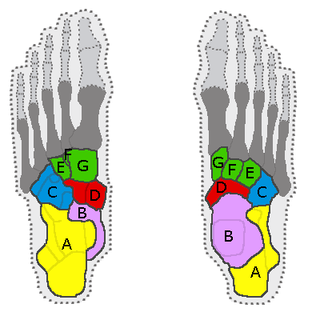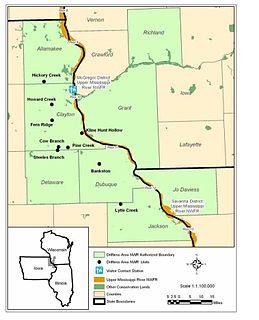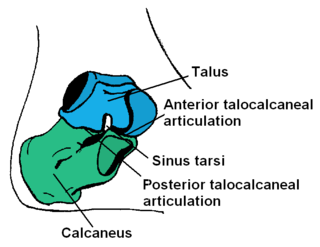
The tibia, also known as the shinbone or shankbone, is the larger, stronger, and anterior (frontal) of the two bones in the leg below the knee in vertebrates, and it connects the knee with the ankle bones. The tibia is found on the medial side of the leg next to the fibula and closer to the median plane or centre-line. The tibia is connected to the fibula by the interosseous membrane of leg, forming a type of fibrous joint called a syndesmosis with very little movement. The tibia is named for the flute tibia. It is the second largest bone in the human body next to the femur. The leg bones are the strongest long bones as they support the rest of the body.

Scree is a collection of broken rock fragments at the base of a cliff or other steep rocky mass that has accumulated through periodic rockfall. Landforms associated with these materials are often called talus deposits. Talus deposits typically have a concave upwards form, where the maximum inclination corresponds to the angle of repose of the mean debris particle size. The exact definition of scree in the primary literature is somewhat relaxed, and it often overlaps with both talus and colluvium.

In the human body, the tarsus is a cluster of seven articulating bones in each foot situated between the lower end of the tibia and the fibula of the lower leg and the metatarsus. It is made up of the midfoot and hindfoot.

Driftless Area National Wildlife Refuge is a United States National Wildlife Refuge in northeastern Iowa, southwestern Wisconsin and northwestern Illinois. It is a non-contiguous collection of parcels in the vicinity of the Upper Mississippi River National Wildlife and Fish Refuge.

The talus, talus bone, astragalus, or ankle bone is one of the group of foot bones known as the tarsus. The tarsus forms the lower part of the ankle joint. It transmits the entire weight of the body from the lower legs to the foot.

In human anatomy, the subtalar joint, also known as the talocalcaneal joint, is a joint of the foot. It occurs at the meeting point of the talus and the calcaneus.
Trumpetflower or trumpet flower may refer to several plants:
Mehmet Naim Talu was a Turkish economist, banker, politician and former Prime Minister of Turkey.

Collomia is a genus of flowering plants in the family Polemoniaceae. Species in the genus are known generally as trumpets, mountain trumpets, or trumpet flowers. They are native to North America and southern South America. The genus name comes from the Greek kolla ("glue"), a reference to the seeds, which become gelatinous in texture when wet.

Collomia grandiflora is a western North American annual plant in the phlox family (Polemoniaceae), known by the common names grand collomia, large-flowered mountain trumpet, and large-flowered collomia. It usually appears in sandy habitats and is cultivated as an ornamental.

Collomia linearis is a species of flowering plant in the phlox family known by the common names tiny trumpet and slenderleaf collomia. This tiny wildflower is native to North America where it is fairly widespread across the north and west. It is an annual herb, rarely exceeding 30 centimetres (12 in) in height, with a velvety erect stem bearing long, narrow green leaves. Atop the stem is a cluster of up to 20 white or light pink flowers, each about a centimeter across. Each has five small rounded petals and stamens tipped with anthers bearing white pollen.
Rainy Lake Falls is a waterfall on the inlet stream of namesake Rainy Lake in Chelan County, Washington. The stream heads in a pair of small lakes and the remaining portions of the Lyall Glacier, and flows down a cascade that is said to be approximately 850 feet (260 m) high.
Unlike the flexible flat foot that is commonly encountered in young children, congenital vertical talus is characterized by presence of a very rigid foot deformity. The foot deformity in congenital vertical talus consists of various components, namely a prominent calcaneus caused by the ankle equines or plantar flexion, a convex and rounded sole of the foot caused by prominence of the head of the talus, and a dorsiflexion and abduction of the forefoot and midfoot on the hindfoot. It gets its name from the foot's resemblance to the bottom of a rocking chair. There are two subcategories of congenital vertical talus namely idiopathic or isolated type and non-idiopathic type which may be seen in association with arthrogryposis multiplex congenital, genetic syndromes and other neuromuscular disorders.

Collomia diversifolia is a species of flowering plant in the phlox family known by the common name serpentine collomia. It is endemic to California, where it is an uncommon member of the serpentine soils flora in the North Coast Ranges from the northern San Francisco Bay Area to Shasta County. It is a small annual herb with many branches bearing dark, slightly hairy, lance-shaped leaves, the most basal ones having three small teeth. The inflorescence is a cluster of several flowers each about a centimeter wide. The star-shaped flower has pointed violet lobes with yellowish bases coming together at a purple throat.

Collomia heterophylla is a species of flowering plant in the phlox family known by the common name variableleaf collomia. It is native to western North America from British Columbia to Idaho to central California, where it grows in several types of habitat, including open areas on gravelly mountain slopes. It is a hairy annual herb producing a branching, erect stem. As the common name suggests, the leaves are variable in shape, the lower generally with several toothed lobes and the upper sometimes lacking lobes. The inflorescence is a cluster of flowers emerging from the top of the stem or from the axil of a leaf. It may bear up to 25 flowers, each with star-shaped corolla at the tip of an elongated tube. The corolla lobes are lance-shaped and white to deep pink with white bases.

Collomia tinctoria is a species of flowering plant in the phlox family known by the common name staining collomia. It is native to the western United States from Washington to Montana to California, where it grows in open, rocky habitat in mountains. It is an annual herb producing a slender, branched stem no taller than about 8 centimeters. The glandular, hairy leaves are lance-shaped. The inflorescence is composed of two or three flowers emerging from the leaf axils. Each flower has pointed sepals tipped with awns. The flower has a purplish tube and a pinkish corolla.

Collomia tracyi is a species of flowering plant in the phlox family known by the common name Tracy's collomia. It is endemic to northern California, where it grows in the coniferous forests of the mountain ranges, including the Klamath Mountains. It is an annual herb producing a slender, branched stem no taller than about 8 centimeters. The glandular, hairy leaves are lance-shaped. The inflorescence is composed of two or three flowers emerging from the leaf axils. Each flower is white to lavender and up to 2 centimeters long. This species can be distinguished from the more common and widespread Collomia tinctoria by the positioning of the stamens and stigma in the flower.
Talu Kola is a village in Chahardangeh Rural District, Chahardangeh District, Sari County, Mazandaran Province, Iran. At the 2006 census, its population was 111, in 50 families.
Talu Bagh is a village in Esfivard-e Shurab Rural District, in the Central District of Sari County, Mazandaran Province, Iran. At the 2006 census, its population was 957, in 234 families.












